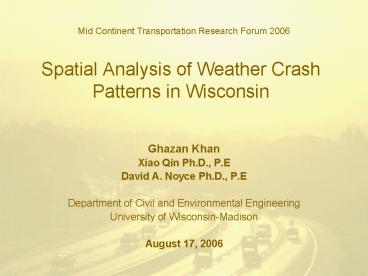Spatial Analysis of Weather Crash Patterns in Wisconsin PowerPoint PPT Presentation
1 / 21
Title: Spatial Analysis of Weather Crash Patterns in Wisconsin
1
Spatial Analysis of Weather Crash Patterns in
Wisconsin
Mid Continent Transportation Research Forum 2006
- Ghazan Khan
- Xiao Qin Ph.D., P.E
- David A. Noyce Ph.D., P.E
- Department of Civil and Environmental Engineering
- University of Wisconsin-Madison
- August 17, 2006
2
Outline
- Background
- Problem Statement
- Objectives
- Data Collection
- Data Analysis
- Results
- Conclusions and Recommendations
3
(No Transcript)
4
Background
- Oct. 2002, I-43 Sheboygan County, Deadliest crash
in Wisconsin-10 fatalities, 39 injuries - 1,023,000 (16) Weather-related crashes in the US
in 2003 - WisDOT considering Road Weather Safety Audit
implementation
5
Problem Statement
- Where should Road Weather Safety Audits (RWSA) be
conducted - What are the locations of weather-prone areas
- How to quantify road weather safety performance
- How to utilize weather data in a proactive
approach towards road safety
6
Objectives
- Identification of weather-prone locations on a
county level - Identification of weather-prone locations on a
road segment level - Establishment of a procedure for the utilization
of crash and weather data collectively
7
Data Collection
- Weather-related crashes in Wisconsin 2000-2002
for fog, rain, snow - Relative crash rate defined
- RWIS Data
- Winter Severity Index 2000-2002
- National Weather Service Cooperative Observing
Network (COOP) data from National Climatic Data
Center (NCDC) - Automated Weather Observing System (AWOS)
8
Data Analysis
- Spatial Statistical procedure for Identifying
spatial patterns of clustering, Getis-Ord Gi
statistic - H0 Weather-related crashes display no clustered
patterns and are randomly distributed hence not
affected by weather - Ha Weather-related crashes show clustered
patterns signifying that they are affected by
weather - The location of clustered patterns are
weather-prone areas
9
County Level Analysis of Weather Related Crashes
- Relative crash rate for each county in Wisconsin
(fog, snow, and rain crashes) - Definition Ratio of weather to all crashes
- Statistically significant spatial patterns of
clustering at various location - Temporal consistency of spatial patterns
- Comparison with weather data
10
County Level Spatial Patterns of Fog-Related
Crashes
11
County Level Spatial Patterns of Snow-Related
Crashes
12
County Level Spatial Patterns of Rain-Related
Crashes
13
Weather Data Analysis (point..)
14
Grid Level Analysis
- Maps of Wisconsin divided into 5 by 5 km grid
sections - Relative crash rate for weather-related crashes
and weather parameter calculated for each grid - Statistically significant spatial patterns of
clustering at various locations - Relationship between weather-related crashes and
weather parameter - Example Snow-related crashes
15
Relative Crash Rate for Snow-related Crashes by
Grid Locations in Wisconsin 2000 2002
16
Statistically Significant Spatial Patterns for
Snow-related Crashes using Getis-Ord Gi
Statistic 2000 2002
17
Relationship between Snow Crashes and Intensity
18
Results Summary
- Weather related crashes on a county / grid level
show statistically significant and consistent
spatial patterns of clustering - Weather prone locations are areas of
statistically significant high crash rate
clusters - Comparisons with weather data verify and validate
the accuracy of the results
19
Contributions
- Sites of promise identified through
statistically significant results on
Macro/Micro-level - Unique procedure quantifying road weather safety
by incorporating both crash and weather data - Address the weather problem both reactively and
proactively - Procedures can help in the assessment of
countermeasures implemented - Evaluation of multiple sources of weather data
identified to supplement RWIS data
20
Recommendation
- Road Weather Safety Audits should be conducted to
assess the actual impacts of weather at locations
identified - Input of winter maintenance staff is very
important - Procedures should be applied to current data
21
Questions?

